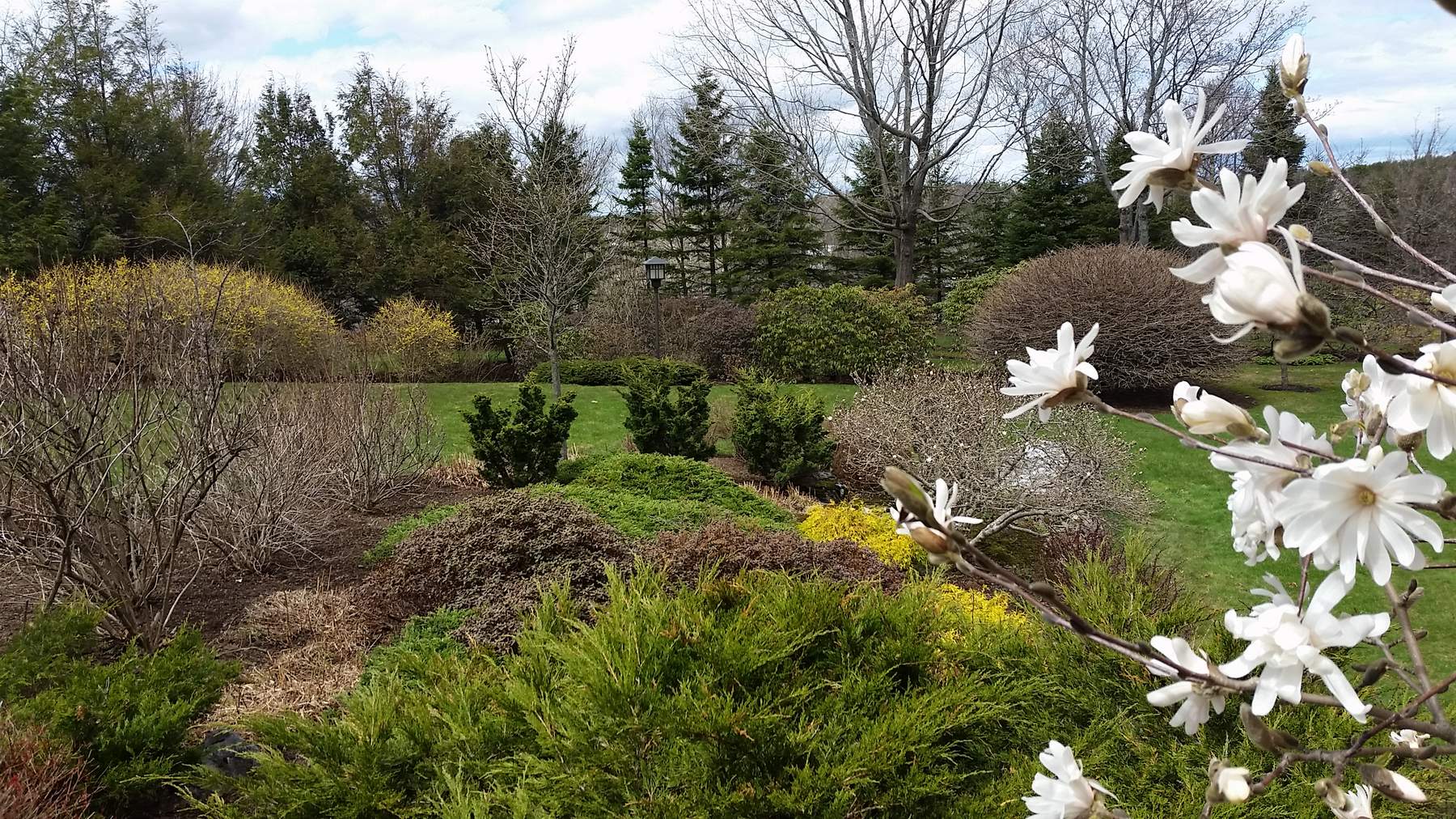Telegraph Journal Gardening Column
.For 2025, my column will appear in the Telegraph Journal every other Thursday, April 17 till mid September
Duncan's garden column Telegraph Journal May 16, 2017
The earliest flowering tree to brave exposing its delicate beauty to the cool spring winds is star magnolia (Magnolia stellata vars.). They began their snowy display around here in the first few days of May, and are reaching their prime right now. Like most flowering trees and shrubs, the entire bloom show falls within a 3 week span. The show is so dramatic that to many it is worth the 49 week wait for an encore. The trick to avoiding letdown as the petals of your star performer start dropping is to have several more varieties to look forward to… flowering crabs, hawthorns and ivory silk trees in June, butterfly bush in July, hydrangeas in August and September, and the red foliage of burningbush and maple in October. Since many avid gardeners are “mature” individuals like myself, for whom the seasons whiz back around again at alarmingly greater rate each year, waiting for trees to bloom again (or Christmas to come again) is a minor issue. Sorry to you younger gardeners who may really shed a tear as your magnolia petals start to drop!
This photo I took last week at a client’s garden in Saint John, and I purposely kept the gorgeous star magnolia blooms off to the side so you could see the much larger and older individual in the distance. Its flower buds are just beginning to show a bit of white, approximately two weeks behind the one in the foreground. Though you can’t tell in this shot, the nearer magnolia is planted four feet out from a south facing wall, with brown siding behind it, and shelter from the northwest wind. That warm microclimate allowed that magnolia to bloom two weeks earlier than its counterpart on the north-facing bank, which is the opposite to a south-facing wall in microclimatic terms. This could be useful information to you at your house, if you are considering trying a perennial or shrub that is considered delicate, eg., a zone 6 plant. Blue hydrangea (commonly sold in box stores in full bloom) would be a good example, or a hybrid rose, as plants that often succumb to winter cold. Pick the warmest microclimate you can find around your house, typically, as this one is, against the foundation on the south or east-facing wall, to try the delicate plant. Regardless of your success, please don’t come to me for a guarantee replacement!
I always enjoy studying such garden scenes as this one, to see the successes and failures which inform future garden decisions. Variation in height is an attractive attribute to a successful garden scene. Larger flowering shrubs like weigela, forsythia, magnolia and burningbush are complemented by their shorter neighbours, spreading juniper, gold cypress, and Ramapo rhododendron. The form of shrubs can add interest, as long as you don’t smooth it out too much with a shearing-pruning technique. The three dark evergreens in the middle, blaauw junipers, are not only darker than all their neighbours, but uniquely vase-shaped. Notice too that they are in a group of 3, much more effective than one or two. Four, five, six or more would usually be even more impressive. That is the concept of mass planting, one that seldom disappoints the viewer. Finally, the subtle variation in colour and texture of the evergreen shrubs adds year-round interest to the scene, valuable in this half of the year when most flowers and deciduous foliage have not yet emerged. Ramapo rhododendron has a rich mahogany tint to its broad-leaf evergreen foliage, while gold cypress is bright yellow, contrasting perfectly with the greens, and mint julep juniper has attractively feathery foliage.
I was quite taken aback upon arriving at another client’s garden the other day and seeing this gorgeous blue-flowered perennial in full bloom. She said we planted it for her just one year ago, and look at it now. Siberian bugloss is a perennial valued for its colourful variegation and great shade tolerance, more so than its month of delicate blue flowers, which remind me so much of forget-me-nots. But I must say, blue is a striking colour to me anytime I see it in a floral display, and I’ll be planting some of these deer-resistant beauties at my house soon!
Like a broken record, I have to return once more to griping about the weather. Considering the main winter seemed relatively mild (witness how hard it was to have a fishing shack on the Kennebecasis River due to thin ice, and skaters fell through the ice), the frost in the ground was impressively deep and long-lasting. Two examples of frost came to light in this past week. I have repeatedly plugged in the water pump of the pond in the garden center all spring waiting for it to start running the waterfall, and it finally started 3 days ago, meaning the pipe in the ground defrosted. And six days ago when I had someone wheelbarrowing the manure pile onto the vegetable garden to till it in, he left a large lump of manure unmoved. When I asked him why, he pointed out that the whole core of the pile, about 4’ cubed, was still frozen solid. That was May 5th. No wonder the spring seems slow to warm up!
Garden Correspondents with Judy Whalen in Gondola Point
Though Judy and Bill are still holding off tilling their two vegetable gardens waiting for the soil to warm and dry, there are perennial crops around them providing some fresh food for the table. “The fiddleheads in our little patch are now just ready to eat. That patch has been there over 20 years now. As long as we don’t over-pick them, they should go for another 20. I have already cut and cooked two pickings of rhubarb. We just love it fresh like that, and it’s so tender this early. The way I figure, there’s going to be way more than we can eat later on when it gets big, so we might as well start using it when it’s small and tender, making for a longer season. And of course the chives are perfect now for cooking or salads. Garlic chives is ready too; it’s a shorter plant and the leaves wider and flatter than its common cousin.”
Judy mentioned another edible plant that I wasn’t familiar with eating at all. “A few years back, I acquired some perennial sorrel plants, which is actually classed as a herb, but makes a fairly good green.” I sensed a little hesitation in Judy’s endorsement, so pried into it further. “Well, they are nice when they are young and tender early in the season, but it’s not a mild green like spinach or fiddleheads. There’s a bit of a tang to it.” Nothing that lots of butter and salt wouldn’t take care of, I suggested, and Judy agreed.
Judy and Bill have collected most of the early blooming plants hardy to our area. “The star magnolia is in full bloom. There’s a bright blue carpet of squill (Scilla) in large patches in the back yard lawn. The daphne just finished its early show of tiny mauve flowers, and I have a heath planted right beside it, whose mauvy-pink flowers went perfectly with it. That’s a fun challenge to pick two or more plants with overlapping bloom times and harmonizing colours , and plant them together in a bed where their harmony will be appreciated.
The magnolia in the foreground started blooming a week or more ahead of the one on the north-facing slope in the distance. The near one is in a warm microclimate against the south wall of the house.

